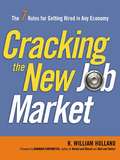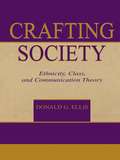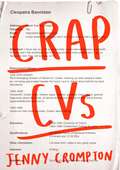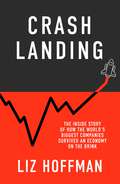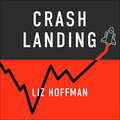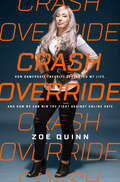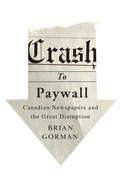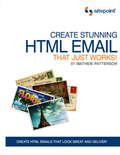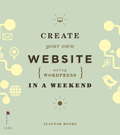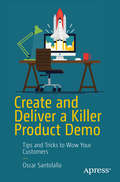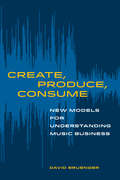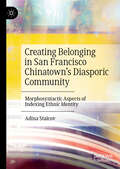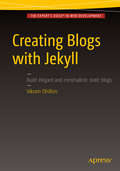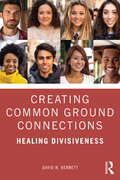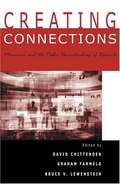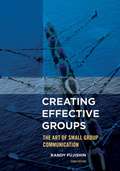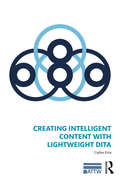- Table View
- List View
Cracking the New Job Market: The 7 Rules for Getting Hired in Any Economy
by R. William HollandForget everything you think you know about landing a well-paid jobùthe rules have changed forever.The rules for finding professional work once seemed clear and unwavering: capture career highlights in a resume, practice answers to standard interview questions, and do lots of face-to-face networking. Cracking the New Job Market shows how these rules have changed and delivers new job-hunting strategies that actually work. The key, rather than to emphasize past accomplishments, is to sell your self on the value you can create for an employer. This new approach to getting hired requires new skills. Author R. William Holland, a human resources insider, shows job seekers how to: ò Gather information on what a prospective employer finds important ò Emphasize those skills, accomplishments, and qualities in tailored resumes and interview answers ò Identify the intersection between personal talents and what the marketplace needs ò Unlock the networking power of social media ò Negotiate the best possible offer Enlightening and practical, this myth-busting book delivers seven powerful rules for landing a great jobùeven in a difficult economy.
Crafting Society: Ethnicity, Class, and Communication Theory (Routledge Communication Series)
by Donald G. EllisThe study of communication, language, and discourse is at once simple, elegant, and complex. Each of these areas is informed by "micro" subjective experiences of individuals and the "macro" processes of a culture. Communication itself is thoroughly modern yet it seeks anchorage in the traditions of the humanities and social sciences. All of this creates a significant challenge. In this monograph, Ellis considers the study of communication as he discusses three key issues in communication theory: (1) the growing emphasis on meaning, (2) the importance of a mediated culture, and (3) the links between micro communication activities and macro social categories such as ethnicity and social class. In response to these three issues, this book deals with the way people use language and communication to construct their world; this world is not constructed purely but is influenced by attitudes, ideologies, and biases. In the modern world the medium of communication has an impact on consciousness and society, and Ellis shows how the media are responsible for some of the fault lines in society. The book also explores principles of medium theory and documents the impact of media on psychological and sociological phenomena. Finally, work of Goffman, Giddens, and Randall Collins is extended to show how micro communication behaviors are implicated in and by social conditions. ADDITIONAL COPY FOR MAILER Expanded features: * The chapters work out a logic connecting real communication patterns with the broad principles upon which societies are explored. Thus the title "Crafting" Society--the crafting is purposefully active to indicate the dynamic processes involved in creating what we call society. Society and culture have their roots and empirical bases in communication; that is, in the daily struggles of interaction. * Two chapters on two of the most important and controversial issues of the day--ethnicity and class. These two chapters are clear illustrations of the new theoretical principles discussed throughout the book. * A chapter on social class is very unique for a book devoted to communication processes. Communication theorists do not usually write about class, even though it is a highly symbolic process and rooted in communication patterns. Class is a difficult concept in America since so few people, other than sociologists, care to talk about it. * A chapter on medium theory takes the bold step of experimenting a little by summarizing basic causal statements and propositions. This device underscores the goal of a theory which is to come to grips with testable statements. The focus is on medium theory and how the media influence consciousness and social structure. * A unique chapter takes up the issue of how communication processes are constitutive of social structures. It draws on work by Giddens and others to return to a concept of structure based on actions that produce and reproduce structure.
Crafting Stories for Virtual Reality
by Melissa Bosworth Lakshmi SarahWe are witnessing a revolution in storytelling. Publications all over the world are increasingly using immersive storytelling—virtual reality, augmented reality and mixed reality—to tell compelling stories. The aim of this book is to distill the lessons learned thus far into a useful guide for reporters, filmmakers and writers interested in telling stories in this emerging medium. Examining ground-breaking work across industries, this text explains, in practical terms, how storytellers can create their own powerful immersive experiences as new media and platforms emerge.
Crap CVs
by Jenny CromptonA HILARIOUS COMPILATION OF THE WORST JOB APPLICATIONS IMAGINABLE - A PERFECT STOCKING FILLER OR OFFICE SECRET SANTA GIFT THIS CHRISTMAS. Ever read a truly terrible job application? Or perhaps slightly exaggerated the truth on one of your own...We've all been there - but these are worse. So much worse. From overly-honest cover letters, embarrassing typos, and mortifying personal revelations, to awkward interview questions, misplaced self-confidence, and, of course, outright lies. This hilarious collection of shockingly dreadful job applications, crap CVs and excruciating interviews will have you laughing out loud, while also making you feel so much better about yourself - because at least you weren't ever this bad . . .Application for EmploymentI refer to the recent death of the Technical Manager at your company and hereby apply for the replacement of the deceased manager.Each time I apply for a job, I get a reply that there is no vacancy but in this case I have caught you red-handed and you have no excuse because I even attended the funeral to be sure that he was truly dead and buried before applying.Attached to my letter is a copy of my CV and his death certificate.The Interview:Q. Is there anything about this job that you feel you might not be very good at?A. Dealing with people.Q. What person, living or dead, would you most like to meet?A. The living one.
Crash Landing: The Inside Story Of How The World's Biggest Companies Survived An Economy On The Brink
by Liz HoffmanIt was the ultimate test for CEOs, and almost none of them saw it coming.__________In early March 2020, with the Dow Jones flirting with 30,000, the world's biggest companies were riding an eleven-year economic high. By the end of the month, millions would be out of work, iconic firms were begging for bailouts, and countless small businesses were in freefall. Slick consulting teams and country-club connections were suddenly of little use: business leaders were fumbling in the dark, tossing out long-term strategy and making decisions on the fly-decisions, they hoped, that might just save them.In Crash Landing, award-winning business journalist Liz Hoffman shows how the pandemic set the economy on fire-but if you look closely, the tinder was already there.Based on astonishing access inside some of the world's biggest and most iconic companies, this is a gripping account of the most remarkable period in modern economic history, revealing how they battled against an economic catastrophe for which there was no playbook: among them, AirBnB's Brian Chesky, blindsided by a virus in the middle of a high-stakes effort to go public; American Airlines's Doug Parker, shuttling between K Street and the White House, determined to secure a multi-billion-dollar bailout; and Ford's Jim Hackett, as his assembly lines went from churning out cars to ventilators.Crash Landing reveals the fear, grit, and gambles of the pandemic economy, while probing its implications for the future of work, corporate leadership, and capitalism itself, asking: Will this remarkable time give rise to newfound resilience, or become just anothercostly mistake to be forgotten?__________A gripping account of the financial carnage of the pandemic, revealing the fear, grit, and gambles that drove the economy's winners and losers.
Crash Landing: The Inside Story Of How The World's Biggest Companies Survived An Economy On The Brink
by Liz HoffmanAn exposé of the billionaires who built the US economy on sand, and the virus that saw it crumble.A kaleidoscopic account of the financial carnage of the pandemic, revealing the fear, grit, and gambles that drove the economy's winners and losers-from a leading Wall Street Journal reporter.Crash Landing takes readers behind the scenes of an unprecedented period of global economic turmoil, letting readers into the inner lives of the men and women trying to save big business from the brink.The world's most powerful CEOs never saw it coming, especially after a decade of growth that saw them riding high. Then whispers of a new flu-like illness became a crescendo, and by the end of March 2020 ten million people were out of work, iconic firms were begging for bailouts, and countless small businesses were in freefall.How do you sustain a workforce that can no longer work? How do you ride out a crisis that has no end in sight? How do you prepare for a recovery in a new world? Liz Hoffman pulls back the curtain on the most violent few months in the modern global economy, taking readers inside boardrooms, onto factory floors and into trading pits. Featuring original interviews with the people responsible for the economy, and in charge of making sure it survives. A gripping story of big business and even bigger characters, Crash Landing will appeal to fans of Michael Lewis and Andrew Sorkin. This is an audiobook that gives you the inside scoop, and answers the most important question of today: Will this remarkable time give rise to newfound resilience, or become just another costly mistake to be forgotten?(P) 2022 Hodder & Stoughton Limited
Crash Override: How Gamergate (Nearly) Destroyed My Life, and How We Can Win the Fight Against Online Hate
by Zoe Quinn<P>You've heard the stories about the dark side of the internet--hackers, #gamergate, anonymous mobs attacking an unlucky victim, and revenge porn--but they remain just that: stories. Surely these things would never happen to you. <P>Zoe Quinn used to feel the same way. She is a video game developer whose ex-boyfriend published a crazed blog post cobbled together from private information, half-truths, and outright fictions, along with a rallying cry to the online hordes to go after her. They answered in the form of a so-called movement known as #gamergate--they hacked her accounts; stole nude photos of her; harassed her family, friends, and colleagues; and threatened to rape and murder her. But instead of shrinking into silence as the online mobs wanted her to, she raised her voice and spoke out against this vicious online culture and for making the internet a safer place for everyone. <P>In the years since #gamergate, Quinn has helped thousands of people with her advocacy and online-abuse crisis resource Crash Override Network. From locking down victims' personal accounts to working with tech companies and lawmakers to inform policy, she has firsthand knowledge about every angle of online abuse, what powerful institutions are (and aren't) doing about it, and how we can protect our digital spaces and selves. <P>Crash Override offers an up-close look inside the controversy, threats, and social and cultural battles that started in the far corners of the internet and have since permeated our online lives. Through her story--as target and as activist--Quinn provides a human look at the ways the internet impacts our lives and culture, along with practical advice for keeping yourself and others safe online.
Crash to Paywall
by Brian GormanIn 2014, when Postmedia acquired Quebecor's Sun Media newspaper and online assets, there was a sense that the recent history of newspapers was repeating itself not as comedy or tragedy, but as eulogy. Crash to Paywall shows that while the newspaper business was weakened by decreases in advertising revenues and circulation, much of its problems stem from self-inflicted damage and business practices dating back to the 1970s. Brian Gorman explores the Canadian newspaper industry crisis and the relationship between the news media and the public. He challenges both the popular mantra that a "perfect storm" of unforeseen circumstances blindsided a declining industry and the narrative that readers were abandoning newspapers, causing advertisers to turn away from "dying" media. Gorman argues that observers had been warning for decades that the business was creating its own problems by acquiring ever-larger debt and shareholder obligations while steadily cutting back on journalists' resources. Finally, by providing journalism for free online, newspaper companies devalued their most important resource and impaired their profitable print products. With dozens of interviews conducted with leading Canadian journalists and editors, Crash to Paywall brings to light the many misconceptions, generalizations, omissions, and highly suspect conclusions about the present state of newspapers and their future.
Crash to Paywall: Canadian Newspapers and the Great Disruption
by Brian GormanIn 2014, when Postmedia acquired Quebecor's Sun Media newspaper and online assets, there was a sense that the recent history of newspapers was repeating itself not as comedy or tragedy, but as eulogy. Crash to Paywall shows that while the newspaper business was weakened by decreases in advertising revenues and circulation, much of its problems stem from self-inflicted damage and business practices dating back to the 1970s. Brian Gorman explores the Canadian newspaper industry crisis and the relationship between the news media and the public. He challenges both the popular mantra that a "perfect storm" of unforeseen circumstances blindsided a declining industry and the narrative that readers were abandoning newspapers, causing advertisers to turn away from "dying" media. Gorman argues that observers had been warning for decades that the business was creating its own problems by acquiring ever-larger debt and shareholder obligations while steadily cutting back on journalists' resources. Finally, by providing journalism for free online, newspaper companies devalued their most important resource and impaired their profitable print products. With dozens of interviews conducted with leading Canadian journalists and editors, Crash to Paywall brings to light the many misconceptions, generalizations, omissions, and highly suspect conclusions about the present state of newspapers and their future.
Crea il tuo blog vincente
by Valeria Bragante Rafa OsunaCrea il tuo blog vincente di Rafa Osuna Letture che ti aiuteranno a creare un blog di successo. Stai pensando di cominciare a scrivere in un blog o ne hai già uno e non ti è chiaro cosa fare? In questo caso, questo libro è per te. Cosa troverai in questo libro? O meglio... che ne pensi se comincio a dirti cosa non troverai? In questo libro non troverai filosofia a buon mercato riguardo i blog. Quella che tentano di venderti le persone che non hai mai avuto successo con un blog. In questo libro non troverai un corso tecnico su come iniziare un blog. Oggi le piattaforme di creazione di blog sono così intuitive e facili da usare che non vale la pena perdere tempo leggendo un libro su questo. Se cerchi questo, ti raccomando qualcuno dei tanti tutorials che ci sono in Youtube su questo tema. Cerca in Internet. Non troverai nemmeno formule magiche per diventare milionario in due settimane con il tuo blog. Se qualcuno ti offre una cosa del genere, scappa immediatamente. Quello che troverai in questo libro è un breve riassunto di ciò che ho scritto nel mio blog personale ((El Último Blog) durante gli ultimi dieci anni. 10 anni nei quali non solo ho continuato il mio blog ma ho diretto una rete di blog con più di 50 redattori, ho partecipato a blog collaborativi, ho tenuto conferenze e corsi sui blog, ho partecipato a varie pubblicazioni. Ciò che ho voluto offrirti in questo libro, come riassunto di questi 10 anni di blogging, è una scelta dei 15 articoli che credo riflettano in modo chiaro e conciso tutto ciò di cui hai bisogno per avere successo con il tuo blog. Sono 15 articoli che ho scelto tra più dei 2000 che ho pubblicato in questi anni. Articoli che ho adattato per la pubblicazione in questo libro, in modo che, mantenendo la freschezza di un post, avessero un certo collegamento tra loro. In questo modo, spero di essere riuscito, con alcune letture veloci, tipiche dei post di
Create Stunning HTML Email That Just Works: Create HTML5 Emails That Look Great and Deliver!
by Mathew PattersonCreate Stunning HTML Email That Just Works is a step-by-step guide to creating beautiful HTML emails that consistently work. It begins with an introduction to email covering topics such as: how email design differs from web design; permission based marketing, and the anatomy of an email. What You Will Learn:How to design HTML emails that look greatSimple methods to design & test email newslettersBest practice, permission based email marketing tips & techniquesProven strategies for selling email design services to your clientsThe book shows the reader how to plan, design, and build gorgeous HTML email designs that look great in every email program: Outlook, Gmail, Apple Mail, etc. All-important tasks like legal requirements, testing, spam compliance and known hacks and workarounds are covered.
Create Your Own Website (Using Wordpress) in a Weekend
by Alannah MooreBuilding a website doesn't have to be complicated or expensive. Create Your Own Website Using WordPress in a Weekend demonstrates how anyone can create a website that looks professional, while being entirely tailored to their needs and preferences.Carefully structured step-by-step tutorials cover every stage of the process, so no specialist knowledge is needed. With beautiful website examples and tips throughout for inspiration, every reader will be able to get themselves - or their business - online in just a couple of days.
Create Your Own Website (Using Wordpress) in a Weekend
by Alannah MooreBuilding a website doesn't have to be complicated or expensive. Create Your Own Website Using WordPress in a Weekend demonstrates how anyone can create a website that looks professional, while being entirely tailored to their needs and preferences.Carefully structured step-by-step tutorials cover every stage of the process, so no specialist knowledge is needed. With beautiful website examples and tips throughout for inspiration, every reader will be able to get themselves - or their business - online in just a couple of days.
Create Your Writer Platform: The Key to Building an Audience, Selling More Books, and Finding Success as an A uthor
by Chuck SambuchinoCreating a platform isn't just beneficial--it's essential! In today's world of blogging, websites, Twitter feeds, and Facebook updates, building a writer platform from the ground up can seem a daunting task. Never fear--author and editor Chuck Sambuchino provides expert, practical advice for increasing your visibility, selling more books, and launching a successful career. In Create Your Writer Platform, you'll learn: The definition of a platform--and why you should start building one now. How to harness the 12 Fundamental Principles of Platform. "Old School" and "New School" approaches to platform, from article writing and conference speaking to website development, blog posts, and social media avenues. How to develop a platform for nonfiction, fiction, and memoir. In addition to Chuck's invaluable insights, you'll also find 12 case studies from authors with effective platforms, as well as professional advice from literary agents. If you're serious about building a platform tailored to you and your writing--a platform that's going to help you succeed as a writer--look no further than Create Your Writer Platform.
Create and Deliver a Killer Product Demo: Tips And Tricks To Wow Your Customers
by Oscar SantolallaCreate great product demos and sell more of your product with the strategies and inspiration in this book. Insightful interviews are presented with professionals who are giving killer product demos in several types of businesses today. The strategies taught in this book are based on the analysis of product demos that made history and brought millions to their companies (Apple, Intel, Microsoft, Tesla, and more).Every day thousands of companies give demos to sell their products. In pre-sales for enterprise software a bad demo can make your product look too complex to the point where decision makers won't buy it. In Software-as-a-Service (SaaS) you need to quickly convert signups into active and paying users. At a product launch event you want a perfect demo that is both persuasive and memorable. Remember Steve Jobs?What You'll LearnApply a simple step-by-step method to create effective product demonstrationsKnow the 5 steps to create a wow momentStudy the first exhaustive analysis of product demos that made history: Douglas Engelbart’s Mother of All Demos; Steve Job’s Macintosh, iPod, and iPhone; and many moreAvoid common mistakes and maximize your presence as a technical presenterAlign your demo with your sales process in enterprise software, Software-as-a-Service (SaaS), mobile apps, etc.Be aware of trends in technology for product demosWho This Book Is ForStartup entrepreneurs, sales engineers, executive or sales representatives, and other professionals
Create, Produce, Consume: New Models for Understanding Music Business
by David BruengerCreate, Produce, Consume explores the cycle of musical experience for musicians, professionals, and budding entrepreneurs looking to break into the music industry. Building on the concepts of his previous book, Making Money, Making Music, David Bruenger provides readers with a basic framework for understanding the relationships between the artist and audience and the producer consumer by examining the methods underlying creation-production-reception and creation-consumption-compensation. Each chapter offers a different perspective on the processes and structures that lead listeners to discover, experience, and interact with music and musical artists. Through case studies ranging from Taylor Swift’s refusal to allow her music to be streamed on Spotify to the rise of artists supported through sites like Patreon, Bruenger offers highly relevant real-world examples of industry practices that shape our encounters with music. Create, Produce, Consume is a critical tool for giving readers the agile knowledge necessary to adapt to a rapidly changing music industry. Graphs, tables, lists for additional reading, and questions for further discussion illustrate key concepts. Online resources for instructors and students will include sample syllabi, lists for expanded reading, and more.
Creating Belonging in San Francisco Chinatown’s Diasporic Community: Morphosyntactic Aspects of Indexing Ethnic Identity
by Adina StaicovThis book presents a much-needed discussion on ethnic identification and morphosyntactic variation in San Francisco Chinatown—a community that has received very little attention in linguistic research. An investigation of original, interactive speech data sheds light on how first- and second-generation Chinese Americans signal (ethnic) identity through morphosyntactic variation in English and on how they co-construct identity discursively. After an introduction to the community’s history, the book provides background information on ethnic varieties in North America. This discussion grounds the present book within existing research and illustrates how studies on ethnic varieties of English have evolved. The book then proceeds with a description of quantitative and qualitative results on linguistic variation and ethnic identity. These analyses show how linguistic variation is only one way of signalling belonging to a community and highlight that Chinese Americans draw on a variety of sources, most notably the heritage language, to construct and negotiate (ethnic) identity. This book will be of particular interest to linguists - particularly academics working in sociolinguistics, language and identity, and language variation - but also to scholars interested in related issues such as migration, discrimination, and ethnicity.
Creating Blogs with Jekyll
by Vikram DhillonLearn to create your own blog using the Jekyll static site generator. You'll start with a simple template, add new features to it, automate any maintenance, attach social sharing, and begin writing. By the end of Creating Blogs with Jekyll, you will be able to create custom blogs with Jekyll, update the content with ease, and reach out to your readers with minimal effort. Because you've built your blog yourself, you'll know exactly how each component works, and you won't be dependent on an admin panel to maintain it. Creating Blogs with Jekyll equips you with the knowledge to create an elegantly designed blog and scale it to capture more readers. Recapture the magic of writing by creating great content and use an easy workflow in Jekyll to maintain it for blogging. Do new things and write about them in style with Jekyll. Takes you through building a fully functional blog from scratch using Jekyll Provides a fun way to work on a side-project and integrate cutting edge web technologies Teaches you how to update and maintain your awesome blog Jekyll is a simple, secure and very low maintenance blog engine that converts naturally written content in markdown into a beautiful and minimal blog. It allows you to focus on content creation and expressing yourself instead of spending all your time updating the plugins and maintaining the database. Jekyll does not rely on a database as a backend so your blog will be far more secure and reliable than any traditional blogging engines such as WordPress. We live in a day and age where short attention spans make it very difficult to expose a reader to interesting content. What better way to capture a reader's attention and retain viewers by captivating them by your own unique style and taste? Jekyll allows the content to shine with minimal distractions and a greater focus on the content and easy sharing of the content. What you'll learn Choose a base theme appropriate for your style and development Integrate various web technologies that will work well together and enhance your blog Automate social sharing components and comments workflow Make adjustments to themes, views and styles of blog posts Update any of the modular components of the blog and integrate new technologies Implementing Jekyll and deploying static websites for future projects Who this book is for Creating Blogs with Jekyll is for the developer who is ready to move beyond the complexities of maintaining a content management system by creating their own unique blog in their own style. It's for the project manager tired of spending all their time editing their blog on the admin panel and updating the content management system. Creating Blogs with Jekyll is an excellent choice for new developers to start blogging because of the simplicity of Jekyll's theming layer and writing workflow. It's an excellent choice for the web developer wanting to build their blog from scratch and expand their knowledge of higher level web technologies.
Creating Comics as Journalism, Memoir and Nonfiction
by Randy Duncan Michael Ray Taylor David StoddardThis book provides student journalists, artists, designers, creative writers and web producers with the tools and techniques they need to tell nonfiction stories visually and graphically. Weaving together history, theory, and practical advice, seasoned nonfiction comics professors and scholars Randy Duncan, Michael Ray Taylor and David Stoddard present a hands-on approach to teach readers from a range of backgrounds how to develop and create a graphic nonfiction story from start to finish. The book offers guidance on: -how to find stories and make use of appropriate facts and visuals; -nonfiction narrative techniques; -artist's tools and techniques; -print, digital, and multimedia production; -legal and ethical considerations. Interviews with well-known nonfiction comics creators and editors discuss best practices and offer readers inspiration to begin creating their own work, and exercises at the end of each chapter encourage students to hone their skills.
Creating Common Ground Connections: Healing Divisiveness
by David W. BennettThrough an empathetic and positive approach to interpersonal communication, this book guides readers to build on the skills they already possess to communicate—and connect—with others. Author David W. Bennett, Ph.D. approaches communication with the belief that it is at the heart of any human division. This book helps readers find a way to communicate that will help build understanding regardless of each party’s perspective. Written in an approachable and conversational style, the book includes tips, examples, and concept reviews to easily illustrate communication principles readers can take with them beyond their courses or training sessions. An ideal supplement to courses focusing on skills in interpersonal, professional, or business communication, this book can also be used as a communication primer for students or professionals in any field.
Creating Connections: Museums and the Public Understanding of Current Research
by Bruce Lewenstein David Chittenden Graham FarmeloThis fundamentally human need to find out about the world led to the creation of this book.
Creating Effective Groups: The Art of Small Group Communication (Third Edition)
by Randy FujishinThis practical book gives students the fundamental knowledge and skills necessary to communicate more effectively and interact more productively in the small group setting. With the help of this book, any group member can learn the skills necessary to participate in and lead a task group in an effective, productive, and healthy manner. This third edition features all new sections on: . "The Power of Diversity" . "Critically Thinking About Yourself As A Communicator" . "Defensive vs. Supportive Climates" . "Ethical Communication" . "Time Management" . "Impromptu Speaking" . "The Spirit of Collaboration" As well as new end chapter exercises in several chapters focusing on Online Resources and Social Media. "
Creating Inclusive Campus Environments For Cross-cultural Learning And Student Engagement
by Shaun R. Harper Sylvia HurtadoDiversity, multiculturalism, and inclusion are values espoused by most colleges and universities; yet many educators, including those in student affairs, expect students to "magically" interact with peers from different cultural backgrounds on their own. With recent calls for accountability in higher education, it is more important than ever for educators to reconsider ways in which they prepare students for participation in a diverse democracy. Creating Inclusive Campus Environments for Cross-Cultural Learning and Student Engagement shows how to capitalize in educationally meaningful ways on the diversity that exists on campuses across the nation. It offers forward-thinking strategies and examples of good practice that will reshape the way readers think about approaching the work of multicultural education. Written by seasoned researchers and emerging scholars in diversity issues and student affairs practice, this provocative book offers practical solutions, innovative models, and pedagogical guides for creating inclusive environments that facilitate learning via cross-cultural engagement. In addition, first-person narrative accounts from undergraduate students provide illuminating insight not often found in other works on diversity. Creating Inclusive Campus Environments is the leading resource for higher education professionals seeking to understand and facilitate cross-cultural learning.
Creating Intelligent Content with Lightweight DITA (ATTW Series in Technical and Professional Communication)
by Carlos EviaCreating Intelligent Content with Lightweight DITA documents the evolution of the Darwin Information Typing Architecture (DITA) – a widely used open standard for structuring technical content. DITA has grown in popularity and features since its origins as an internal grammar for structuring technical documentation at IBM. This book introduces Lightweight DITA (LwDITA, which should be read as "Lightweight DITA") as a proposed version of the DITA standard that reduces its dependence on complex Extensible Markup Language (XML) structures and simplifies its authoring experience. This volume aims to reconcile discrepancies and similarities in methods for authoring content in industry and academia and does so by reporting on DITA’s evolution through the lens of computational thinking, which has been connected in scholarship and media to initiatives for learning to code and programming. Evia’s core argument is that if technical communicators are trained with principles of rhetorical problem solving and computational thinking, they can create structured content in lightweight workflows with XML, HTML5, and Markdown designed to reduce the learning curve associated with DITA and similar authoring methodologies. At the same time, this book has the goal of making concepts of structured authoring and intelligent content easier to learn and teach in humanities-based writing and communication programs. This book is intended for practitioners and students interested in structured authoring or the DITA standard.
Creating Keynote Slideshows: The Mini Missing Manual
by Josh ClarkDon't bore your audience with black bullet points on a white background. Your ideas deserve a presentation that's as smart and elegant as they are. Even if you're new to the Mac, this hands-on guide gets you up to speed on Keynote's features-like time saving themes- fast. You'll learn how to customize layouts to your liking and add even more flash with sound and video.
